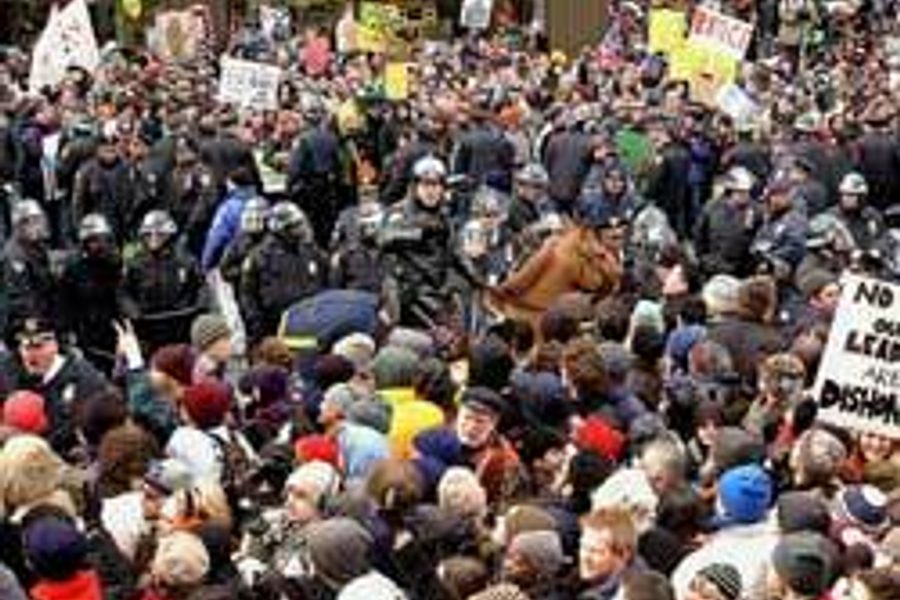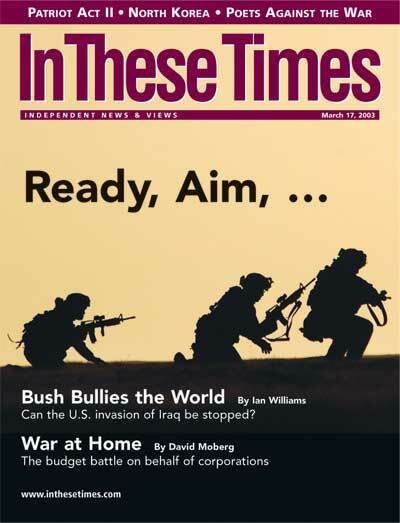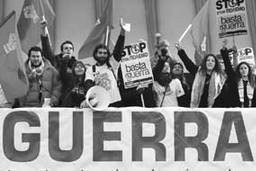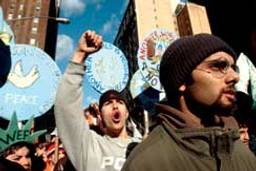
New York—The massive, coordinated outpouring of anti-war protest in more than 600 different cities across the globe on February 15 was something unprecedented in world history. Commentators reached and grasped to come up with anything to compare it with: The parties that wreathed the world during the millennium? The revolutions of 1848?
It was a vast event, the largest protest in history (involving an estimated 10 million people worldwide). An attempt to stop a war before it even started, it saw the marshaling of a new, autonomous, self-organized resistance that began with the globalization movement and now threatens to bring on board masses of mainstream, middle-class citizens.
The fulcrum of all the protests was the U.N. building in Midtown Manhattan, where some 500,000 people gathered on a frigid, windy day-despite everything that the Bush administration and city government had tried to do to stop them. Of all those 600 cities, from Lisbon to Tokyo, New York was apparently the only one in which demonstrators were refused the right to march. (This decision went to the top: The Bush administration sent federal attorneys to file a brief urging federal judges to uphold the city’s decision to deny marchers a permit).
On Saturday protesters at the rally site were to be herded into barricaded protest pens, arranged four to a block, and not allowed to leave without permission. Port-a-potties were conspicuously absent. All streets anywhere near the protest area, which ran north from 51st Street along 1st Avenue, were barricaded. Pedestrians were not allowed through, creating a labyrinth that made it almost impossible to figure out how to actually get to the pens (in fact, the majority of those who came into the city never made it). The 70-odd feeder marches were carefully monitored, and any which tried to take the streets–like the Youth Bloc march I was in–were quickly surrounded by hundreds of riot police and broken up. For the NYPD, total control is a matter of principle.
But on Saturday, for once, they lost it.
The numbers were just too large. Many refused to enter the pens on principle; others rebelled in disgust at the idea of being herded like cattle; by mid-day, as the official rally grew from 51st Street to somewhere in the Eighties (the police actually began to run out of barricades to make new pens), endless thousands spilled over and began to occupy 2nd and 3rd Avenues.
The area became a vast liberated zone, a spontaneous carnival. Crazily costumed troupes put on satirical sketches; masked anarchists climbed on top of bus shelters; pagans performed spiral dances; there was a samba band; buses stood skewed, abandoned, as their drivers watched in bemusement or (in at least one case) stood proudly on the curb waving a giant peace flag.
Squads of police, on horseback or in riot gear, descended fiercely here and there when some barricade was toppled, or just to show they were still around. But it was obvious that, as one officer was overheard shouting in dismay, they had lost control of the streets. They had been overwhelmed by numbers far larger than anyone had anticipated, and their own government’s determination to ensure those numbers looked as small as possible on the evening news (a march, after all, would have been much easier to control).
The Carnival Bloc had called for an after-party in Times Square; thousands arrived to find the whole of Midtown barricaded and shut off; by early evening, riot cops were driving lines of marchers into the streets. Some were beaten, others pepper-sprayed (elsewhere in the country, sit-ins were reportedly broken up with tear gas). An unknown number ended up in the hospital. And small groups of retreating marchers walking legally down sidewalks were arbitrarily rounded up, leading to hundreds of arrests.
Still, nothing could take away from the thrill of the day. “If there’s one thing governments fear the most,” reflected my friend Starhawk, “it’s the prospect of the population becoming ungovernable. The crowd today was very compliant. But they must be shivering in their boots thinking about what it would be like to face a crowd that size if they were really mad.”
We spoke in Times Square, surrounded by mayhem, but with the same computerized headline crawling every two minutes around the building above all the while: rattled by worldwide groundswell of anti-war sentiment, u.s. and britain to redraft u.n. resolution on iraq. If there was ever immediate gratification for a protest, this was it.
These events reflect something very strange, and very important, about the current historical moment. Globalization—the real globalization of democracy that the movement has been calling for since Seattle in 1999—is actually beginning to emerge.
In the 24 hours following the protest, I was deluged with e-mails, many from overseas. One friend in Italy wrote excitedly about the possibility for imagining a truly global citizenship. Another, writing from a squat in Rome, apologized for not having communicated sooner: “I’ve been a bit busy. I just had 3 million people over for dinner!” But mostly they wanted to know what really happened in New York.
Few Americans will probably ever know how large the crowd gathered there was, but Belgians, South Africans and others will know, because they’re not dependent on U.S. news sources. And they’ll also know how remarkable half a million people is in a country where the cops won’t let you march, the morning newspapers won’t tell you how to get to the protest, and local television never, ever, has live coverage of the days’ events.
The Bush administration may not give a hoot that majorities of U.S. citizens oppose his plans, but overseas, politicians are paying close attention. And however ironic it may seem that a majority of Americans must now depend on Jacques Chirac to promote their opinions on the world stage, it also marks the beginning of a new stage of history.
It was a vast event, the largest protest in history (involving an estimated 10 million people worldwide). An attempt to stop a war before it even started, it saw the marshaling of a new, autonomous, self-organized resistance that began with the globalization movement and now threatens to bring on board masses of mainstream, middle-class citizens.
The fulcrum of all the protests was the U.N. building in Midtown Manhattan, where some 500,000 people gathered on a frigid, windy day-despite everything that the Bush administration and city government had tried to do to stop them. Of all those 600 cities, from Lisbon to Tokyo, New York was apparently the only one in which demonstrators were refused the right to march. (This decision went to the top: The Bush administration sent federal attorneys to file a brief urging federal judges to uphold the city’s decision to deny marchers a permit).
On Saturday protesters at the rally site were to be herded into barricaded protest pens, arranged four to a block, and not allowed to leave without permission. Port-a-potties were conspicuously absent. All streets anywhere near the protest area, which ran north from 51st Street along 1st Avenue, were barricaded. Pedestrians were not allowed through, creating a labyrinth that made it almost impossible to figure out how to actually get to the pens (in fact, the majority of those who came into the city never made it). The 70-odd feeder marches were carefully monitored, and any which tried to take the streets–like the Youth Bloc march I was in–were quickly surrounded by hundreds of riot police and broken up. For the NYPD, total control is a matter of principle.
But on Saturday, for once, they lost it.
The numbers were just too large. Many refused to enter the pens on principle; others rebelled in disgust at the idea of being herded like cattle; by mid-day, as the official rally grew from 51st Street to somewhere in the Eighties (the police actually began to run out of barricades to make new pens), endless thousands spilled over and began to occupy 2nd and 3rd Avenues.
|
On Saturday, February 15, anti-war rallies and marches spanned the globe. In what is being hailed as the largest single outpouring of grassroots opposition to war since Vietnam (and some say in history), diverse groups converged to flank the U.N. building in New York and crowd INS headquarters in Seattle, among other American cities. In Europe, crowds were the biggest in countries whose leaders support the American war effort—nearly 1 million protesters gathered in London, Barcelona and Madrid.
|
|
Squads of police, on horseback or in riot gear, descended fiercely here and there when some barricade was toppled, or just to show they were still around. But it was obvious that, as one officer was overheard shouting in dismay, they had lost control of the streets. They had been overwhelmed by numbers far larger than anyone had anticipated, and their own government’s determination to ensure those numbers looked as small as possible on the evening news (a march, after all, would have been much easier to control).
The Carnival Bloc had called for an after-party in Times Square; thousands arrived to find the whole of Midtown barricaded and shut off; by early evening, riot cops were driving lines of marchers into the streets. Some were beaten, others pepper-sprayed (elsewhere in the country, sit-ins were reportedly broken up with tear gas). An unknown number ended up in the hospital. And small groups of retreating marchers walking legally down sidewalks were arbitrarily rounded up, leading to hundreds of arrests.
Still, nothing could take away from the thrill of the day. “If there’s one thing governments fear the most,” reflected my friend Starhawk, “it’s the prospect of the population becoming ungovernable. The crowd today was very compliant. But they must be shivering in their boots thinking about what it would be like to face a crowd that size if they were really mad.”
We spoke in Times Square, surrounded by mayhem, but with the same computerized headline crawling every two minutes around the building above all the while: rattled by worldwide groundswell of anti-war sentiment, u.s. and britain to redraft u.n. resolution on iraq. If there was ever immediate gratification for a protest, this was it.
These events reflect something very strange, and very important, about the current historical moment. Globalization—the real globalization of democracy that the movement has been calling for since Seattle in 1999—is actually beginning to emerge.
In the 24 hours following the protest, I was deluged with e-mails, many from overseas. One friend in Italy wrote excitedly about the possibility for imagining a truly global citizenship. Another, writing from a squat in Rome, apologized for not having communicated sooner: “I’ve been a bit busy. I just had 3 million people over for dinner!” But mostly they wanted to know what really happened in New York.
Few Americans will probably ever know how large the crowd gathered there was, but Belgians, South Africans and others will know, because they’re not dependent on U.S. news sources. And they’ll also know how remarkable half a million people is in a country where the cops won’t let you march, the morning newspapers won’t tell you how to get to the protest, and local television never, ever, has live coverage of the days’ events.
The Bush administration may not give a hoot that majorities of U.S. citizens oppose his plans, but overseas, politicians are paying close attention. And however ironic it may seem that a majority of Americans must now depend on Jacques Chirac to promote their opinions on the world stage, it also marks the beginning of a new stage of history.
David Graeber is a professor of anthropology at Yale University and author of The False Coin of Our Own Dreams: Toward an Anthropological Theory of Value. A contributing editor of In These Times, he is currently working with the Direct Action Network and other activist groups.







